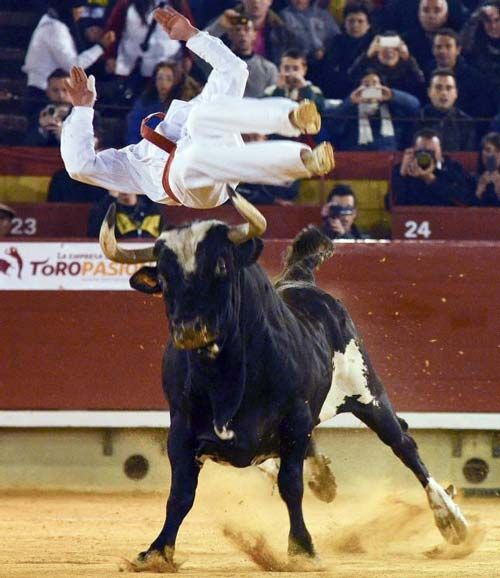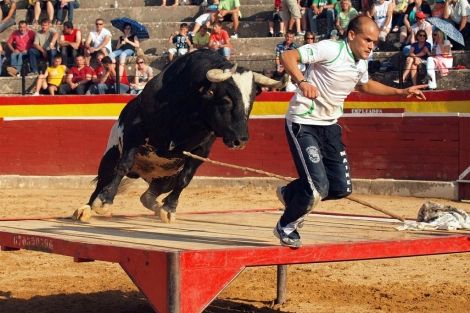Ratón, the 500kg killer and the highest-paid bull in Spain, is dead. He passed away recently and the animal leaves behind a legacy that includes three fatal gorings and a very long trail of wounded people, all of whom had the temerity to stand in his way during local fiestas and the ring.
Far from hurting him, this fearsome track record actually increased his fee and gained him top billing at bull-related events throughout the Valencia region, where he was born and bred.Born in April 2001, 500 kg (1,100 lb) Ratón was the offspring of a bull named Caracol and a cow named Fusilera. He was given his name for his diminutive size as a calf. He first appeared in the bullring in September 2002 and gored a matador for the first time in Canals, Valencia, in 2004. As well as participating in bull running in the streets (encierros in Spanish), Ratón also often performed in the recortes, a style of bullfighting in which members of the public dodge the bull around obstacles such as wooden stairs or platforms placed in a bullring.At one such event held in Museros in 2005, Ratón gored a dozen people and injured several more.

Ratón’s feats gained him international coverage, and English-language publications immediately dubbed him “the killer bull.” The Wall Street Journal even put Ratón on its front cover on September 28, 2011. He chalked up his first victim in 2006, when he gored a 54-year-old man more than 10 times in Puerto de Sagunto. In 2008, he did it again in Benifairó, and a third time in 2011 in Xátiva, where he charged a 29-year-old man, sending him several meters up in the air. The victim, who was intoxicated at the time, died on impact.
Ratón (which, ironically, means “mouse” in Spanish) was almost 13 years old at the time of death, which is a very advanced age for a bovine. But this did not prevent him from being the main attraction at any fiesta he happened to attend. The last time he was seen in action was March 15 at the Valencia bullring.
.jpeg)
The animal’s owner, Gregorio de Jesús, explained that Ratón’s body will be stuffed and placed on public display at his estate outside the small town of Sueca.
De Jesús pointed out that the famous steed died on another one of his properties, Finca Ràfol, where he had enjoyed a personal space protected from the rain, the cold and the heat, pampered to the very end of his days.
“Ratón was limping for the last month and a half,” said Gregorio García, the owner’s father. “In the morning he still got up, but then he lay back again and never recovered.”
The bull was under veterinary treatment and Ratón was always greatly stressed by the procedure of loading and unloading him onto the transportation truck.
Ratón was born on April 12, 2000, and two years later began performing at Valencian fiestas, where local governments pay breeders to provide animals for events ranging from professional bullfights and bullruns, to free-for-alls, where anyone can jump into the ring to test his mettle (participants are almost invariably male).
Ratón’s black legend began with the 2006 goring in Puerto de Sagunto. Far from getting him put down, this actually saw his fee raised. Suddenly, his owner began getting offers from scores of other municipalities, who were anxious to draw attention to their own fiestas. There are hundreds of towns in the Valencia region that hold bull-related festivities.
In 2011, for instance, Xátiva paid 10,000 euros for the privilege of having Ratón for under an hour. His owner contends that he came cheap even at that price, because it allowed local authorities to literally double the price of the tickets to access the ring, which was packed. On other occasions he has been paid up to 15,000 euros for 45 minutes when the average price for a fighting bull at these type of events was 1000 euros.
The internet quickly filled up with hundreds of videos capturing some of his most spectacular performances; Ratón soon had a Facebook page and a Wikipedia entry. Posters announced his presence at local fiestas with images of Ratón running after someone, or climbing up a protection ramp, or staring defiantly at the public. In fact, he was advertised much as a bullfighter would be, with his name written in large letters.

“He is nimble, intelligent and fast. He is a very happy bull. He is not brutish like the other bulls, who act on instinct and charge against everything. This one thinks, analyzes the situation and then attacks,” said his owner, right after the 1,100-pound beast gored a 27-year-old in the neck.
After that incident, Gregorio de Jesús considered retiring the animal, and putting him out to stud. But he didn’t. “What do you do if they place a blank check in front of your face and tell you, ‘Write down whatever amount you want’?”, he asks, as if trying to excuse his actions. However Ratón was lightly worked compared to other fighting bulls; whereas his counterparts were usually on tour all year, Ratón's appearances were limited to ten a year and only in regions where bullfighting regulations do not require the animal to be killed after the fight. At 10 years old, Ratón's age was equivalent to that of a 60-year-old human. He was due to retire in 2010, but due to demand from fans and municipalities organising fiestas, his owner, Gregorio de Jesús, decided to prolong the bull's career.
De Jesús is a former matador who began his bullfighting career in Mexico in 1993 and later became a bull rancher in Sueca, which is 30 kilometers from Valencia. He compares Ratón with Muhammad Ali, one of the best boxers in history, thanks to his deft skill despite being a heavyweight.
Upon news of his death, the mayor of Sueca told the daily Las Provincias that “we’ll have to pay some kind of tribute to him. He was a symbol of this place.”
Meanwhile, his legacy lives on in songs, t-shirts and videogames based on his life and deeds — and in his son, Ratoncito.
source el pais